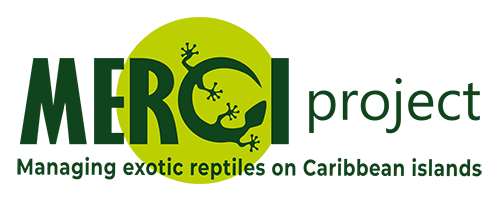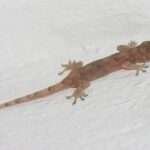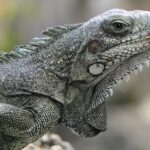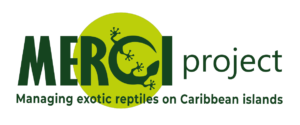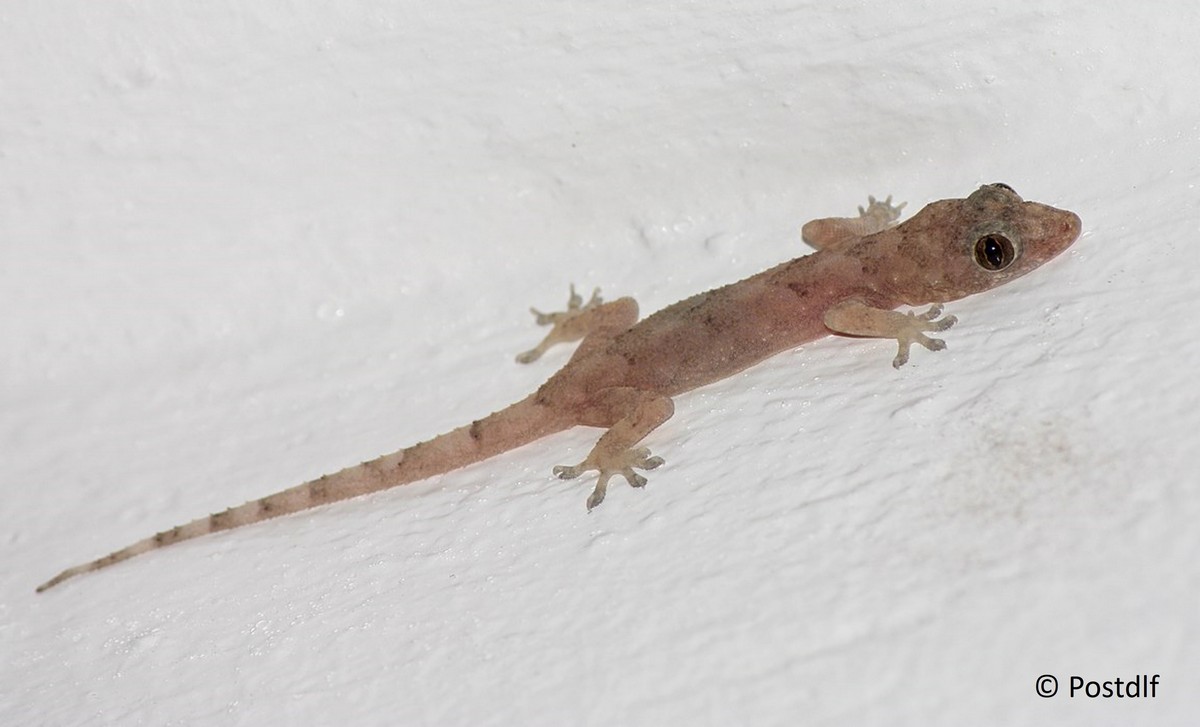
- Common name: House gecko, Moreau’s tropical gecko, Wood slave gecko, Wood slave
- Scientific name : Hemidactylus mabouia (Moreau de Jonnès, 1818)
- Local name: Hémidactyle commun, Gecko des maisons
- Ordre : Gekkonidae
- Famille : Squamata
Description
Morphology. The House gecko is a medium-sized gecko, characterised by the presence of a long claw on all five fingers, numerous tubercles on the back, and six rows of spiny tubercles on sides of the tail (Powell et al. , 1998; HerpMe, Société Herpétologique de France). The body colour and dorsal patterns vary from white and light gray to dark brown. The tail is usually marked with dark rings (Powell et al., 1998; HerpMe, Société Herpétologique de France).
Standard body size (snout vent length). males: 42 to 67,9 mm; females: 42 to 72 mm (Powell et al., 1998; HerpMe, Société Herpétologique de France).
Sexual dimorphism. Females are generally larger than males.
Variations. The body colour of the same individual can vary from light to dark, depending on its physiological condition.
Possible confusion with other species. In the Antilles, confusion is possible with the Mourning gecko Lepidodactylus lugubris. However, the Mourning gecko is characterised by the presence of claws on four out of five fingers (absent on the thumb), a smooth-looking body without tubercles, with a dorsal pattern consisting of black symmetrical spots, sometimes discrete, « V » or « W » shaped, or in the form of dots. The base of the tail is slightly enlarged (HerpMe, Société Herpétologique de France).
Distribution
Native. Africa: Mali, Senegal, Guinea, Ivory Coast, Ghana, Togo, Benin, Nigeria, Tchad, Cameroun, Gabon, Sao Tomé and Principe, Central African Republic, Democratic Republic of the Congo, Angola, Namibia, Republic of South Africa, Eswatini, Republic of South Sudan, Uganda, Tanzania, Zambia, Zimbabwe, Eritrea, Ethiopia, Kenya, Mozambique, Seychelles (e.g. Powell et al., 1998).
Introduced. Florida (Krysko and Daniels, 2005; Meshaka et al., 2006; Meshaka, 2011; Burke et Lieto, 2019), Mexico, Honduras (McCranie, 2015), Costa Rica, Panama, Colombia, Venezuela (Fuenmayor et al., 2005), Guyana, Surinam (Jairam et al., 2016), Guyane (Hoogmoed, 1975), Ecuador (Torres-Carvajal et al., 2019), Peru, Bolivia, Brazil (Telles et al., 2015; Mageski et al., 2017; Franzini et al., 2019; Oliveira Neves et al., 2019; Cozer et al., 2020), Paraguay, Uruguay, Argentina (Torres et al., 2018), Madère (Jesus et al., 2002).
Caribbean: Bermuda (Outerbridge and Massey, 2018), Eleuthera Island (Bahamas) (Johnson et al., 2013), Great Inagua (Bahamas) (Griffing et Bauer, 2016), Cuba (Iturriaga and Marrero, 2013; Schettino et al., 2013; Borroto-Paez and Pérez, 2019, 2020), Grand Cayman, Brac Island (Barnett et al., 2020), Jamaïque, Turks and Caicos Islands (Reynolds, 2012), Mona, Culebra, Puerto Rico, Vieques, American and British Virgin Islands, Anguilla (Howard et al., 2001), Antigua, Barbuda, Redonda (Daltry, 2007), Saint Martin, Saint Barthelemy (Lorvelec et al., 2007), Bonaire, Saint Eustache, Saba, Saint Kitts and Nevis, Montserrat, Guadeloupe (Lorvelec et al., 2007), Dominica, Martinique (Lorvelec et al., 2007), Sainte Lucia, Grenada, Saint Vincent and the Grenadines, Barbados, Trinidad, Tobago (Auguste, 2019), Curaçao (Hughes et al., 2015).
Biology and ecology
Habitat. The global distribution of the House gecko reflects its preference for tropical to sub-tropical climates (Rödder et al. 2008). The species is able to cope with a great diversity of natural and anthropized habitats. Hemidactylus mabouia is particularly abundant in forest habitats, as well as in urban and suburban areas.
Diet. Feeds mainly on small arthropods: insects, arachnids and crustaceans (Rocha et Anjos, 2007; Iturriaga and Marrero, 2013).
Reproduction. Reproduction occurs throughout the year, with a peak from August to December. Females are able to store sperm, and can lay eggs up to seven times a year. Two eggs are laid per nest, and incubation lasts 22 to 68 days (58 days on average).
Behaviour. The House gecko is a territorial species which can behave aggressively towards its congeners or other reptile species.
Impact and management of introduced populations
Impact. Hemidactylus mabouia can compete with native species. Hughes and colleagues (2015) observed in Curaçao the displacement of the native gecko, Phyllodactylus martini, from usually occupied sites, under pressure from the House gecko.
Other authors have also reported competitive interactions with a native Cuban anole species, Anolis porcatus, without observing any displacement of the species (Borroto-Paez et Pérez, 2019).
Management. To date, no targeted control measures have been established in the different regions where the species has been introduced.
Bibliographie
- Auguste, R. J. (2019). Herpetofaunal checklist for six pilot protected areas in Trinidad and Tobago. Herpetology Notes, 12, 577–585.
- Barnett, J. C., Poe, S. J., & Haakonsson, J. (2020). Hemidactylus mabouia (Wood Slave). British West Inides. Herpetological Review, 51, 540.
- Borroto-Páez, R., & Pérez, D. R. (2019). Competitive interference between an endemic Cuban Green Anole (Anolis porcatus) and invasive Tropical House Geckos (Hemidactylus mabouia). IRCF Reptiles and Amphibians, 26, 43–46.
- Borroto-Páez, R., & Pérez, D. R. (2020). Predation by a Cuban Treefrog Cuba (Osteophilus septentrionalis) and a domestic cat (Felis catus) on Tropical House Geckos (Hemidactylus mabouia) in central Cuba, with a review of predators and vertebrate prey of Tropical House Geckos. IRCF Reptiles and Amphibians, 27, 120–128.
- Burke, R., & Lieto, M. (2019). Tracking the spread of six invasive amphibians and reptiles using the geographic distribution records published in Herpetological Review. Herpetological Review, 50, 1–7.
- Cozer, J. S., Pereira-Ribeiro, J., Linause, T. M., Ferreguetti, A. C., Bergallo, H. de G., & da Rocha, C. F. D. (2020). Reptile diversity in the duas bocas biological reserve, espírito santo, Southeastern Brazil. Papeis Avulsos de Zoologia, 60, 1–9.
- Daltry, J. C. (2007). An introduction to the herpetofauna of Antigua, Barbuda and Redonda, with some conservation recommendations. Applied Herpetology, 4, 97–130.
- de Oliveira Neves, M., Yves, A., Pereira, E. A., Alves, L., Vasques, J. B., Teixeira Coelho, J. F., & Silva, P. S. (2019). Herpetofauna in a highly endangered area: The triângulo Mineiro region, in Minas Gerais State, Brazil. Herpetozoa, 32, 113–123.
- Franzini, L. D., Da Silva, I. R. S., Santana, D. O., Delfim, F. R., Vieira, G. H. C., & Mesquita, D. O. (2019). Lizard fauna from the state of Paraíba, northeastern Brazil: current knowledge and sampling discontinuities. Herpetology Notes, 12, 749–763.
- Fuenmayor, G. R., Ugueto, G. N., Bauer, A. M., Barros, T., & Manzanilla, J. (2005). Expansion and natural history of a successful colonizing gecko in Venezuela (Reptilia: Gekkonidae: Hemidactylus mabouia) and the discovery of H. frenatus in Venezuela. Herpetological Review, 36, 121–125.
- Griffing, A. H., & Bauer, A. M. (2016). Hemidactylus mabouia (Wood Slave). Bahamas: Great Inadua. Herpetological Review, 47, 80–81.
- Hoogmoed, M. S. (1975). An annotated checklist of the lizards of french Guiana, mainly based on two recent collections. Zoologische Mededelingen, 49, 141–172.
- Howard, K. G., Parmerlee, J., & Powell, R. (2001). Natural history of the edificarian geckos Hemidactylus mabouia, Thecadactylus rapicauda, and Sphaerodactylus sputator on Anguilla. Caribbean Journal of Science, 37, 285–288.
- Hughes, D. F., Meshaka, W. E., & Van Buurt, G. (2015). The superior colonizing gecko Hemidactylus mabouia on Curaçao: Conservation implications for the native gecko Phyllodactylus martini. Journal of Herpetology, 49, 60–63.
- Iturriaga, M., & Marrero, R. (2013). Feeding ecology of the Tropical House Gecko Hemidactylus mabouia (Sauria: Gekkonidae) during the dry season in Havana, Cuba. Herpetology Notes, 6, 11–17.
- Jairam, R., D’Orgeix, C. A., D’Orgeix, C. H., & Harris, A. (2016). range extension and distribution of the invasive Moreau’s Tropical House Gecko, Hemidactylus mabouia (Moreau de Jonnès, 1818) (Squamata: Gekkonidae), in Suriname. Check List, 12, 1978.
- Jesus, J., Freitas, A. I., Brehm, A., & Harris, J. (2002). An introduced population of Hemidactylus mabouia (Moreau de Jonnès, 1818) on Madeira Island. Herpetozoa, 15, 179–180.
- Johnson, S. K., Parmerlee, J. S., Eifler, D. A., & Powell, R. (2013). Comparative water-loss rates of Hemidactylus mabouia and Sphaerodactylus notatus on Eleuthera Island, Commonwealth of the Bahamas. Herpetology Notes, 6, 471–475.
- Krysko, K. L., & Daniels, K. J. (2005). A key to the Geckos (Sauria: Gekkonidae) of Florida. Caribbean Journal of Science, 41, 28–36.
- Lorvelec, O., Pascal, M., Pavis, C., & Feldmann, P. (2007). Amphibians and reptiles of the French West Indies: Inventory, threats and conservation. Applied Herpetology, 4, 131–161.
- Mageski, M., Jesus, P. R., & Ferreira, P. D. (2017). Continued dispersal of the Wood Slave Gecko , Hemidactylus mabouia, in natural environments of Brazil. North-Western Journal of Zoology, 13, 363–364.
- McCranie, J. R. (2015). A checklist of the amphibians and reptiles of Honduras, with additions, comments on taxonomy, some recent taxonomic decisions, and areas of further studies needed. Zootaxa, 3931, 352–386.
- Meshaka, W. E. (2011). A runaway train in the making: the exotic Amphibians, Reptiles, Turtles, and Crocodilians of Florida. Monograph 1. Herpetological Conservation and Biology, 6, 1–101.
- Meshaka, W. E., Cress, H. L., Kingsland, K. L., Smith, H. T., Fitchett, S. A., Moore, J. A., & Cowan, M. (2006). Hemidactylus (House Gecko) assemblage dynamics on South Florida buildings. Journal of Kansas Herpetology, 17, 2–3.
- Outerbridge, M. E., & Massey, S. C. B. (2018). Two new additions to the terrestrial reptiles established on bermuda, with notes on other species. Herpetological Review, 49, 508–510.
- Powell, R., Crombie, R. I., & Boos, H. E. A. (1998). Hemidactylus mabouia (Moreau de Jonnès). Catalogue of American Amphibians and Reptiles, 674, 1–11.
- Reynolds, R. G. (2012). Hemidactylus mabouia (Tropical House Gecko). Distribution. Caribbean Herpetology, 28.
- Rocha, C. F. D., & Anjos, L. A. (2007). Feeding ecology of a nocturnal invasive alien lizard species, Hemidactylus mabouia Moreau de Jonnès, 1818 (Gekkonidae), living in an outcrop rocky area in southeastern Brazil. Brazilian Journal of Biology, 67, 485–491.
- Rödder, D., Solé, M., & Böhme, W. (2008). Predicting the potential distributions of two alien invasive Housegeckos (Gekkonidae: Hemidactylus frenatus, Hemidactylus mabouia). North-Western Journal of Zoology, 4(2), 236–246.
- Schettino, L. R., Mancina, C. A., & González, V. R. (2013). Reptiles of Cuba : checklist and geographic. Smithsonian Herpetological Information Service, 144, 98.
- Telles, F. B. S., Militão, C. M., Bergallo, H. G., & Rocha, C. F. D. (2015). Invasion of the alien gecko Hemidactylus mabouia (Moureau de Jonnès, 1818) in a natural habitat at Praia do Sul Biological Reserve, Ilha Grande, RJ, Brazil. Brazilian Journal of Biology, 75, 768–770.
- Torres-Carvajal, O., Pazmiño-Otamendi, G., & Salazar-Valenzuela, D. (2019). Reptiles of Ecuador: A resource-rich online portal, with dynamic checklists and photographic guides. Amphibian and Reptile Conservation, 13, 209–229.
- Torres, P. J., Escalante, O., & Cardozo, D. (2018). First record of the invasive Hemidactylus mabouia (Moreau de Jonnès, 1818) (Squamata, Gekkonidae), in the dry Chaco, Argentina. Check List, 14, 633–636.
